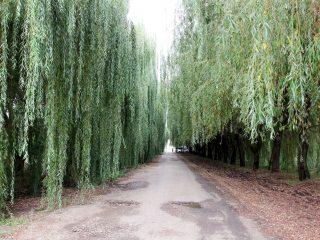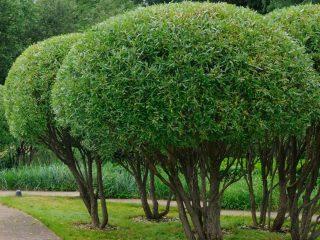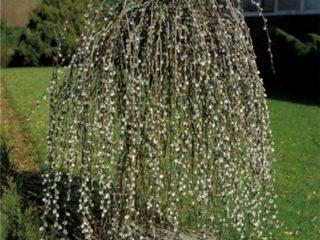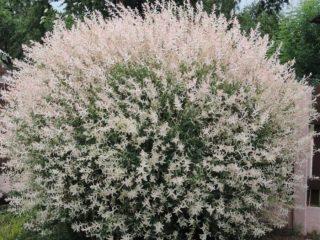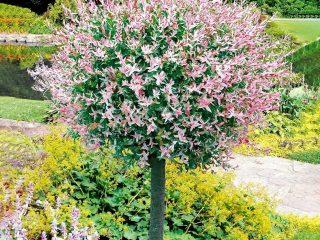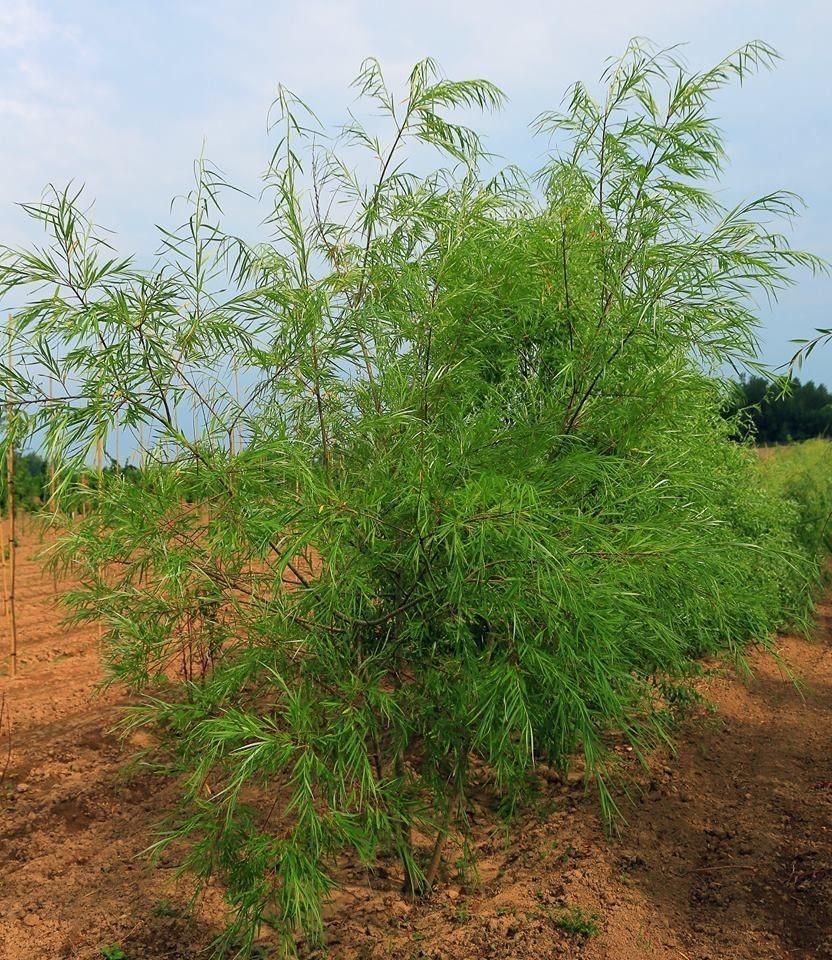Content
Weeping willow is an extremely common plant that is found in almost all countries of the world. Wet areas have become the tree's favorite places: floodplains, coastal strips, lowlands. In modern gardening practice, different types of weeping willow are grown - and each has its own unique characteristics.
What does a weeping willow look like?
The tree belongs to the deciduous group. In the northern hemisphere it is one of the most commonly found plants.

Scientists believe that the willow grew long before the advent of man and has remained almost unchanged since then.
The foliage has an elongated structure and can reach more than 2.5 cm in width and 15 cm in length. Its color is ambiguous and depends on the location - near the base the leaf blades are darker. The edges of the leaves are usually outlined by a light line, but there may not be one (depending on the variety).
Crown height and diameter
As you can see in the photo, the weeping willow on the site grows both up to 30 m and up to 5 m.This is influenced by two factors. The first and most important is varietal affiliation. The second is the environment, that is, the type of soil, the nature of lighting, the presence of pests and other factors affecting the life of the flora.
The diameter of the crown, accordingly, is also different and on average reaches 4-5 m. The trunk of the weeping willow is approximately the same - it is about 1.3 m in diameter. It will not be possible to grasp the massive base of a tree, unless it is very young.
Roots, fruits and flowers
Before the buds open, catkins form on the weeping willow. As a rule, they are located on small branches. The fruits are light-yellow in color and oval in shape. Inside are small seeds covered with a thin layer of lint.
The weeping willow would not have climbed so high on the evolutionary ladder if not for its strong root system. Thanks to its branched structure, the plant receives more liquid than other trees.
In adult weeping willows, the roots are directed so deep that they are able to draw water from ground sources. This allows the crop to calmly survive even severe drought.

It is noteworthy that the moister the substrate, the wider and more intensively the roots grow, they improve the condition of the soil
Among other trees, the weeping willow is chosen for growing in the country, because it protects the site from erosion.
Depending on the type, the foliage can be silver, ordinary green, light green or white. Many varieties are united by the shape of the leaf blade, which has already been described.There are also varieties in which soft down grows on the foliage, and there are also more “formidable” weeping willows - with a thorny edge. The leaves of the weeping willow are best described by the photo.
The flowering period begins in February, March or June - again, depends on the species. At this time, the weeping willow produces flowers. They are not as noticeable as those of shrub plants and have a small diameter. The inflorescences are arranged in a friendly manner, they can be distinguished by their grayish-yellow hue and the increased excitement among bees trying to get the juiciest sample.
Types of weeping willow
Currently, there are hundreds of species and varieties of weeping willow. Some were obtained as a result of natural selection, some through breeding. Below are the most beautiful and frequently encountered varieties that are not picky about external conditions.
Weeping white willow
The plant loves warm climates and is found in Near Asia and Europe. The weeping willow is notable for the size of its trunk - it stretches up to 30 m in height. The crown is made up of small branches, sometimes curved in bizarre shapes.

The leaves of the white tree are long and shiny, have a light green color.
Even young seedlings are distinguished by their winter hardiness and unpretentiousness to the soil structure. Experts recommend the weeping willow because it thrives within the city. One of the reasons was the decorative shape of the crown (it does not always grow weeping). If pruned correctly, the plant will resemble a huge tent in shape.
When choosing a white willow variety, it is worth considering Tristis. It was bred specifically for landscaping areas.The tree is not that big - it grows only up to 15 m - but it has an interesting crown.

The color of the bark is usually yellowish or light brown (by autumn the trunk becomes darker)
Yellow weeping willow
This variety is suitable for those looking for a large shrub. In its natural environment it lives in Europe. Due to its rich golden hue, the plant looks extremely interesting. Yellow weeping willow does not need shelter for the winter, but requires proper placement (prefers light areas).

Willow is still not picky about the composition of the soil.
The leaves stretch up to 13 cm in length. The tree tolerates frost well, surviving temperatures below -35 °C. The shoots of the shrub are small, but very pliable - thanks to this feature, the weeping yellow willow has become a frequent guest in parks, because with its help it is easy to create hedges.
dewy willow
The tree grows in Asia, as well as in the eastern part of Russia. Representatives of the species reach 14-16 m in height, have a strong trunk and lush foliage. To shape the crown of a weeping willow, regular pruning is necessary. Its branches grow downward, but they do so very quickly (annual growth is up to 1.5 m).

The leaves are small - only up to 10 cm in length
Yellowbark willow
The species was developed by crossing the white and Babylonian varieties. The weeping willow grows up to 22 m. It has a beautiful crown that resembles an air cushion. The trunk of the tree is smooth, which is not typical for many willows.

The plant got its name because of the color of the bark and shoots.
Willow whole leaf
The culture can be found in Japan. It is a dwarf shrub, the maximum height of which reaches no more than 3 m. The diameter of the crown is equal to half the height of the trunk - 1.5 m. Like other shrubs, the shoots of the weeping willow are flexible, it is easy to intertwine them.

Using pruning, willow can be given different shapes
Where does the weeping willow grow?
Scientists count hundreds of varieties of weeping willows. Most of them are concentrated in the North. The tree is easy to find in Siberia, European countries, China and North America. It also grows in the Moscow region, in the central part of the Russian Federation. It is usually found near lakes and rivers.
How many years does the weeping willow live?
The age limit depends not so much on external factors as on the species. If we take trees, the weeping willow lives for at least a century. Dwarf varieties are less durable - they live on average up to 50-70 years.
Planting weeping willow
Planting work begins with choosing a location. Weeping willow loves moist substrates not covered by shade. It is preferable that the area is protected from the wind. Seedlings can be placed in slight shade.
In its natural habitat, willow grows near bodies of water. This is also important to consider. The size of the pit is selected based on the diameter of the earthen clod, adding a little reserve to it. The depth is made equal to 65 cm.
Before planting, the hole is filled with fertilizer: compost, rotted manure or other organic matter. There should be a lot of feeding - enough to form a mound. In good weather, the weeping willow is carefully removed from the pot and transplanted into a prepared hole. The seedling is buried to the brim.
After this, the soil needs to be compacted, watered and mulched. At the initial stages, water consumption should be about two buckets per tree. Peat or wood is used as mulching material.
Weeping willow care
According to experts, even a beginner can handle caring for a weeping willow. Regardless of whether it is a shrub or a tree, the plant tolerates cold and drought well and actively develops after planting. For the first year, the plant is watered once a week. In summer, re-wetting is allowed.
If the crown begins to dry out, this is a clear sign of moisture deficiency. Even if the owner constantly waters the plantings, the tree may be uncomfortable due to dry air. To correct the situation, it is necessary to irrigate the crown with a sprayer.

You should not water during the day - the weeping willow can get burned in the sun
The interest of gardeners is often caused by the lack of need to fertilize. In this regard, the plant can be called independent. Some, trying to reach the peak of decorativeness, still use fertilizers. They accelerate the development of green mass and promote the growth of roots.
A popular additive is rotted organic matter: vegetation, old manure, etc. You can also use store-bought drugs - they also give an excellent effect. In Siberia, young specimens are sheltered for the winter. Adults don't need this.
How to properly prune a weeping willow
To curb continuous growth (especially for shrubs), the owner needs to regularly trim the shoots. Seedlings taller than 1 m are allowed to do this.Weeping willow is pruned annually - in the spring, after flowering and before the arrival of frost.
It is important to control the number of buds; several are left on each branch, directed upward. In the future, even shoots will grow from them, which will go down as they gain mass. With this pruning, the shape of the weeping willow will be neat.
Diseases and pests
Like other trees, weeping willow can fall victim to pests and diseases. Powdery mildew and white rot are common ailments that plague the crop. To “disarm” infections, annual treatment with fungicides is necessary. Especially in the early stages.
Insecticides will help control insects. Because of the latter, the leaves dry out, the crown and trunk become dull.

You need to act in a timely manner, otherwise you will have to deal with the consequences
Photos in landscape design

Willow goes perfectly with conifers

Willow looks impressive against the background of the forest

Wood is often used to design landscape compositions in the West.

Shade-loving plants are often planted in the tree trunk circle.
Conclusion
The weeping willow is one of the most common trees in the Northern Hemisphere and at the same time one of the most ancient representatives of the flora. The plant is grown everywhere because it is not picky about climate and soil.
